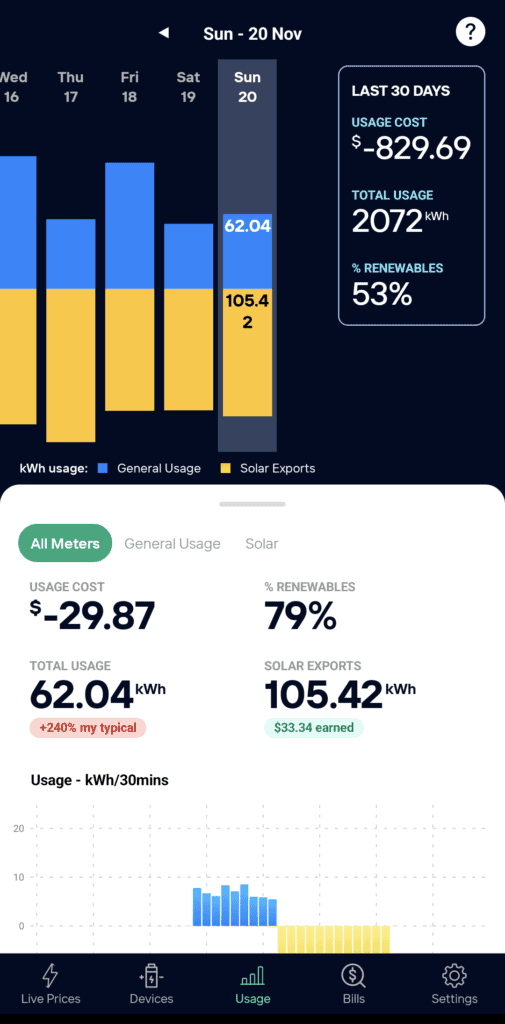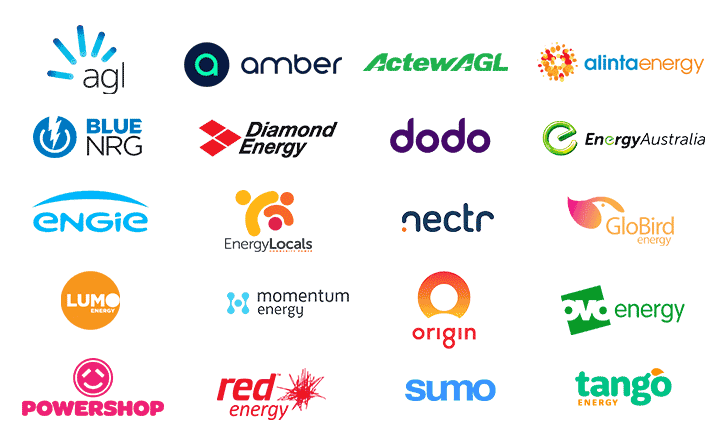Are you looking for shortcuts to make the most of Amber? Over the last 12 months our household developed thirteen hacks on the Amber plan to save time.
Our goal is to achieve a reasonable financial return without keeping a constant eye on changing prices because, like most people, we’re busy throughout the day. How many of these hacks you want to try is up to you.
If your system uses Amber SmartShift, ned or other third-party automation solutions, then many of these hacks will already be done for you. The larger your energy use, solar PV size and battery size, the more value you will get from the relevant hacks. And it’s only really a hack if it results in meaningful savings for you.
So, here are the hacks we use at our place. Over the last 30 days (22nd Oct 2022 to 20th Nov 2022), we achieved a credit with Amber of over $800.
Basic hacks
1. Use apps for information and automation.
There is a range of information and automation apps that help you optimise your energy usage. Here’s a short list of categories, and the apps I use, in brackets
- retail pricing (Amber)
- battery/inverter automation (ned)
- wholesale pricing (NEM Data for 5-minute market prices and supply/demand actuals/forecasts, Other options include AEMO market data, EnergyDash and OpenNem. NemLog for actual/forecast solar/wind curtailment)
- solar forecasts (Solcast)
- EV charging (Charge HQ via Tesla API or OCPP charging station)
- Appliance control (Samsung Smartthings – air purifiers, PurpleAir – local air pollution, Midea Air – dehumidifier, Google Home/Wemo/Kasa/Tapo for smart plugs)
- Air conditioning (Actron Connect)
2. Schedule loads for when power is likely to be less expensive.
That usually means between 9 am to 3 pm. If your load only runs for two hours, schedule from 11 am to 1 pm when prices are generally at their lowest. Weekends tend to be cheaper than weekdays as grid demand is lower. The same advice applies to non-solar owners (buying from the grid) and solar owners wanting to avoid low/negative feed-in tariffs.
3. Schedule your hot water system (HWS) during peak solar generation hours.
Get a sparkie to set up your electric HWS, so it runs on the general tariff (not a controlled load). Use a timer to start it around 11 am to use cheap solar (yours or from the grid). Even better, if it’s a heat pump, it will use less power as it’s more efficient at warmer daytime temperatures.
4. Actively power on/off items when prices are very high or very low.
This sounds obvious but there are Amber customers who when faced by high or low prices just complain rather than acting. High and low prices are part of being an Amber customer. It’s what you do when they come along that matters. If feed-in tariffs are negative and you’re still exporting turn off one or all strings on your solar PV system if you don’t have zero export control. If your buy price goes negative, then turn on high-powered appliances around the home. These are signs the grid needs your help and will pay for it. Equally, if feed-in tariffs are high i.e. over 40c per kWh, discharge your battery and turn off appliances that can be run later.
5. Go easy on yourself. Some hours you win, some hours you lose.
Being on market-linked plans is a bit like sport. Some days you win, other days you lose. You can’t always pick the cheapest time to use energy nor to export when feed-in tariffs are at their highest. Know that if you have a battery and export (rather than import) power at times of peak rates and import when rates are low, you will very likely be better off than on any other retail plan over the course of a year.
Advanced hacks
6. Monitor wholesale pricing outside the Amber app for better insights during price spikes.
The Amber app has some limitations around actuals and forecasts. Amber uses a changing mix of 5-minute actual and forecast prices. As a result, it can be challenging to determine whether price spikes are real or just forecast for the current 30-minute period. Using AEMO’s market data or the NEM Data app can help to determine whether you should take (more) immediate action or not.
7. Check future supply/demand forecasts.
Apps like NEM Data give you visibility of supply and demand in the days ahead. When you know what’s coming up, you can defer EV charging or running major loads to times when supply significantly exceeds demand. This will usually result in low prices. Or conversely, if the forecast is for supply tight supply, you can pre-charge batteries and EVs and run heating/cooling before prices climb.
8. Check solar forecasts for your own home.
Solcast provides a free service for single homes to see the expected generation for your PV system’s location and size. Use it as a guide for sunny, cloudy and dark days. The BOM’s weather forecasts are also handy.
9. Act on price spikes, whether real or forecast.
A bird in the hand is worth two in the bush. The nature of 30-minute Amber pricing means sometimes you must guess whether a price spike will occur and how much it will be. Using the 5-minute pricing, if you see an actual spike, you should export immediately until the end of those 30 minutes. That’s because it may be the only price spike for the day.
Unfortunately, to maximise the value of a price surge, you need to export for 30 minutes if you are on 30-minute pricing. This can be tricky if the price spike isn’t forecasted or the forecast spike doesn’t eventuate. So, for spikes predicted later in the 30-minute window, I usually export flat out from the start of the 30-minute window. As a result, if the price spikes in the last 5 minutes, everything exported during the 30 minutes will be rewarded at the spike price. When you only export based on the actual spike, you will only be exporting for 4-5 minutes. So your earnings are cut by ~85%. In the end, if the spike doesn’t happen, you’ve used some battery.
Unfortunately, this tactic is something you can only do manually using an inverter’s discharge control. There is no way for automation solutions to tell from the Amber pricing whether an actual price spike has occurred until the pricing for the final 5 minutes is available. So automations will follow the Amber pricing and discharge (unless and until the forecast spike disappears). Shifting to 5-minute pricing will fix this challenge.
10. Move to 5-minute pricing.
Will Amber make 5-minute pricing an option? Or perhaps, customers might be moved to 5-minute pricing when 5-minute data is available from their meter? That’s because 5-minute pricing offers better buying and selling opportunities, particularly for devices like batteries that can respond to frequent price changes. This is ideal for minimising exports to just when it matters. Otherwise, you’ll have to export for a whole 30 minutes to capture a spike that could have happened in just the first 5-minute period.
11. Discharge your battery if you’re facing negative feed-in tariffs.
When negative feed-in tariffs are forecast, and you expect to be exporting power through the day, discharge your battery in the early morning. Or discharge in the previous evening peak, as long as you leave some capacity to get through the night. That will leave more capacity for storing your own solar and minimise exports when feed-in tariffs are negative.
12. Switch to a tariff that allows you to buy cheaper and greener daytime power.
Network charges make up a significant portion of retail electricity rates. However, if you’re with Amber, you’re likely willing and able to shift your loads around. This means that you should consider a Time of Use (or alternately, and only if you have a battery, a demand tariff). An increasing number of solar sponge tariffs offer lower daytime network charges. Expect very attractive grid power prices when coupled with the low/negative daytime wholesale rates. Our favourite tariffs include – Ausgrid EA959 Two-way tariff trial with bonus FIT, Daytime Saver in CitiPower, Powercor and United Energy networks in Victoria, 6900 in Energex and the RELE tariff in South Australia. View hours for all residential TOU and demand tariffs to see what’s available in your electricity network.
13. Use the Vehicle to Load (V2L) capability of an EV to supplement your battery storage
While Vehicle to Grid (V2G) and Vehicle To Home (V2G) are tantalisingly close – I see you Nissan Leaf (via Chademo)and Wallbox Quasar and 2023 Cupra Born (via CCS2 and software version 3.1) – there are many EVs in Australia that support V2L today. That includes the BYD Atto 3, MG ZS EV, Hyundai Ioniq 5, Kia eNiro EV and Kia EV6. If you have a compatible battery/inverter setup you can use these cars V2L capability to top up your home battery. This can come in very handy whenever you want more capacity in your home battery e.g. for extended periods of peak rates. We’ve regularly used our Ioniq 5’s V2L capability and a low voltage battery charger to push ~3.7kW into our custom low voltage lithium battery over the last 6 months. This has allowed us to export and earn more during extended periods of high feed-in tariffs. It’s also been handy to add some energy to our depleted home battery so we can avoid buying (mostly) fossil fuels from the grid before our panels start producing the next morning.
14. Automate, automate, automate.
I can’t emphasise this enough. Watching energy prices can be a time sink. Use automation – from simple scheduling to advanced solutions like SmartShift, ned and Home Assistant. This way, you won’t have to check pricing throughout the day. You may like to keep a closer watch during forecast price spikes to ensure you don’t miss out on payouts if you have spare storage to discharge. Your automation solution/s should charge and discharge your battery based on prevailing prices, your preferred battery State of Charge (SOC) levels or history. Plus, it should support zero export control to avoid negative feed-in tariffs.
Extra hacks
Here are some extra hacks that work well with Amber, if you are going all out on energy saving.
Avoid buying high-power appliances that can’t be easily automated.
There are plenty of inverters, storage systems, appliances etc, that you can buy today that can be automated.
Want to automate your EV charging? Buy an OCPP-compatible charging station that can be controlled by you or a third party on your behalf and is or can be solar-aware if your have solar.
If you buy an appliance with no smarts, it is harder to power it cheaply from renewables.
Buy an EV and power it with cheap solar – yours or your neighbours.
EVs are a large shiftable load (7kWh per day for a vehicle driven 14,000km p.a.) that you can power from your rooftop for almost nothing.
Move off expensive gas and petrol
Amber can help customers access the cheapest grid energy and get more value from their solar generation (in conjunction with a battery). Let’s face it. Gas and petrol/diesel will cost you and the community a lot more to use now and in the future. The more energy use you can shift to electricity, the more you will be able to save and the lower you’re emissions will be as the cheapest wholesale rates coincide with the high levels of renewables.
Buy higher output storage systems.
With Amber, the key to higher returns is discharging at a higher rate. Price spikes are usually fleeting. Better to export at 6kW for 1 hour than 3kW for 2 hours as the average feed-in tariff you earn will be lower over the two hours. Ideally, the storage system should be able to store the maximum generation rate of your PV system. If you have a PV system with a 5kW inverter, I’d recommend a storage system that can charge at 5kW or higher. Suppose you need to buy from the grid on cloudy days to charge your battery. That faster charge rate means you can buy in a narrower window, so the average cost to fill your battery for later can be lower.




